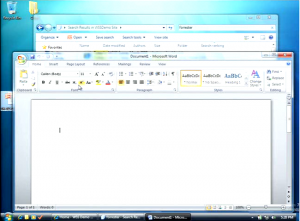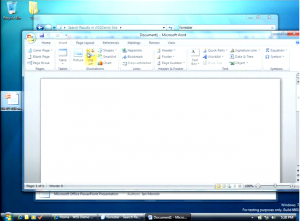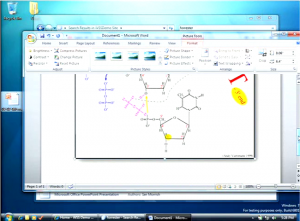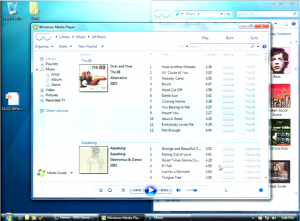Here are some Swing links that you might have missed during the last week:
JavaFX 1.0 is one week away, and the full feature list is still unknown. However, an interesting bug report has found its way to the bug parade (bug 6770914):
http://javaweb.sfbay.sun.com/~ngthomas/javafx/mediaplayer/test.html
This is the javafx media player applet. At the bottom of the applet, there are three buttons, which will trigger a javascript -> fx call:
document.getElementById(“app”).script.playVideo(url);
with will change the video clip playing inside the applet. It works with 6u10, and our latest 6u12 nightly. But with 6u11 b03, document.getElementById(“app”).script is undefined/null
Looks like an applet playing media and being controlled by JavaScript associated with HTML buttons. Is this an example of enhanced applet support? At this point, it will take nothing short of a spectacular collection of applets to make them a viable competitor (and no, dragging the applets to desktop is not going to be it).
Here are some Swing links that you might have missed during the last week:
- Ken Orr explores an interesting usability side of Swing buttons with popup menus. The solution involves using an unpublished “doNotCancelPopup” client property supported by the current implementation of popup handling in core Swing. This may be different in other JVM implementations, and may even break in the future Swing versions (although the later is quite unlikely). Thanks to this post i have also updated the Flamingo command buttons to dismiss popup menu / panel on the second click. The implementation does not use the above client property, since Flamingo has its own code to manage popups.
- Gregg Bolinger has kicked off a series of posts on blueprints for well-written Swing applications (part 1, part 2, part 3 so far). Project Maddie has been created to provide the collaboration grounds for interested developers, and it will be interesting to see how this pans out after the initial excitement is gone. I have talked about the lack of Swing blueprints in May 2006 (just after JavaOne 2006), and unfortunately nothing has changed as far as the proper platform documentation goes.
- Jeremy Wood delves into the intricacies of using existing alpha composites to do cross fades between two translucent images. After finding out that the existing alpha composites are not up to the job, he tries doing direct manipulations on the underlying buffer. As this turns off the hardware acceleration, the time and memory performance were disappointing.
- Gabriele Carcassi provides a solution for registering JavaScript functions to respond to Swing events on applets.
- Following his experimentations in the SwingX incubator, Matt Nathan has decided to create a separate project for scalable icons.
- Geertjan Wielenga writes about the JSyntaxPane project, mentioning the supported editor kits, find / replace dialog, code completion configuration, color styles and more.
- Gregg Bolinger vents his frustration over the opaque and very slow bug fixing process of core Swing bugs. Working on drag-and-drop between tables and lists, he has hit a bug reported in 2003 and not fixed since then. In the next post he presents (a rather poorly formatted) a solution that he found on JavaRanch came up with.
- Wolfgang Zitzelsberger has announced release 2.8 of Synthetica look-and-feel. New in this release are the SyntheticaSimple2D theme, improved translucency / border support for comboBox / spinner / text components, transparent window support for 6u10, improved RTL component orientation support.
- Jean Francois Poilpret has posted the slides to his Jazoon 08 presentation on the JSR 296 (AppFramework).
- Greg Brown shows two examples of building Pivot applications that are wired with JavaScript and Groovy.
- Jeremy Wood talks about his implementation of Aqua-like preference panel thats supports both single-row and multi-row layouts, along with cross fading between the components.
- And finally, Collin Fagan kicks off the new series on exploring layout prototyping. The first part documents his attempts to apply XML to the UI layouts. Layout managers surveyed in this part are absolute, table, grid bag and Mig. It certainly looks like the desktop heavyweights (Adobe and Microsoft) have adopted XML as the lingua franca to enable easier collaboration between designer and developer tools. And while the hardcore developers still prefer writing and tweaking those XML files by hand, both sides of the respective toolchains provide tools that are familiar to the target audience.
Here are some Swing links that you might have missed during the last week:
- Roman Kennke posts an update on the Java2D stack on VxWorks which is now functional enough to run SwingSet2. The followup post has more screenshots of SwingSet2 running under JamaicaVM and OpenJDK stack.
- Looks like JavaFX development is going to bring performance improvements back to Java2D and Swing applications. Bug 6766336 aims to use SSE / MMX CPU instructions to speed up the software pipeline – i have mentioned that while the new Direct3D-accelerated pipeline is great for the modern hardware, the “enterprise” desktops usually only have integrated cards. Bug 6766342 aims to improve the (closed-source) Ductus rasterizer on anti-aliased paths, while bugs 6767500, 6767506 and 6767516 aim to improve performance of various primitives on the hardware accelerated pipelines.
- An interesting bug (6740419) has been opened to provide better control over text grid fitting in Java2D. The subject of printing fidelity has been addressed at length last year by Jeff Atwood and Joel Spolsky, and it looks like the designer team behind JavaFX is pushing for Apple-style font rendering in JavaFX. I have already talked about why it is a bad idea, and the introduction of DirectWrite in Windows 7 (more on this in a later post) will obviate the need to invest the precious time in supporting this feature in JavaFX.
- Jean Francois Poilpret has announced release candidate for release 1.0 of DesignGridLayout.
- Adam Bien compares Eclipse RCP and NetBeans RCP and leans towards the later in his recommendations. I don’t have any experience with NetBeans RCP, but i’ve been doing heavy Eclipse / SWT work over the last three years at work. I have almost never considered SWT / Eclipse to be more limiting that Swing. In fact, once you understand that it’s better not to fight the platform and instead tweak your design to match the recommended UI guidelines of the platform (re vertical labels in tables), you will find SWT / JFace combination (especially with the Instantiations designer) a very productive and enjoyable environment. Not to mention that you can most certainly create non-Eclipse looking SWT applications, and this is going to be much easier in the near future.
- Ayman Al-Sairafi has announced release 0.9.3 of the JSyntaxPane component. New in this release – line numbering, reworked Find / Replace dialog and support for Python, C, C++ and Ruby syntax.
Finally, if you are interested in the responses to my posting on the state of core Swing, you’re welcome to read the following:
And Dale Beermann has an interesting series about moving a large Java project to Flash and ActionScript. The first post addresses the reasons why this port has been done, while part 2, part 3 and part 4 (ongoing series) address the specific technical issues in porting Java code to ActionScript.
Once a subject of heated discussions, the native vs. cross-platform skinning has not been mentioned for quite some time in Swing blogosphere. While this post by no means aims to revive the dead ghosts, i saw something quite interesting in the PDC session on the Windows 7 Explorer. It looks like (at least in the current builds) Microsoft has decided to enforce better consistency across the UI layer of its flagship desktop products, including Office and Media Player. This specific issue has been brought as one of the major arguments against using a native look-and-feel (because the lack of consistency effectively meant that there is no native look-and-feel).
The following three screenshots show (what i presume to be) the next version of Office running on Windows 7. These were taken from the video stream and the quality is not the best, but the overall trend is still quite noticeable. The landmark Office ribbon that was skinnable as silver / blue / black in Office 2007 is now consistent with the platform look-and-feel (read more about the scenic ribbon in the PowerPoint slides of this PDC session). I’m not sure whether the presenter meant to show the new look of Office, or even if this is the final look. However, the screenshots clearly show that the ribbon UI is now much more consistent with the the rest of OS, including the colors, gradients, the glass chrome on the title pane and other UI bits (click to see full size view):



The same goes for the Windows Media Player. The screenshot below (click for full size view) shows a somewhat partial UI in the top bar (no icons on the twin round buttons), but the heavy glossy black / dark blue chrome found in the current Media Player UI is (at least for now) gone:

Standardizing the UI look of different bundled and add-on programs in Windows 7 is an interesting trend that is worth following in the months to come.